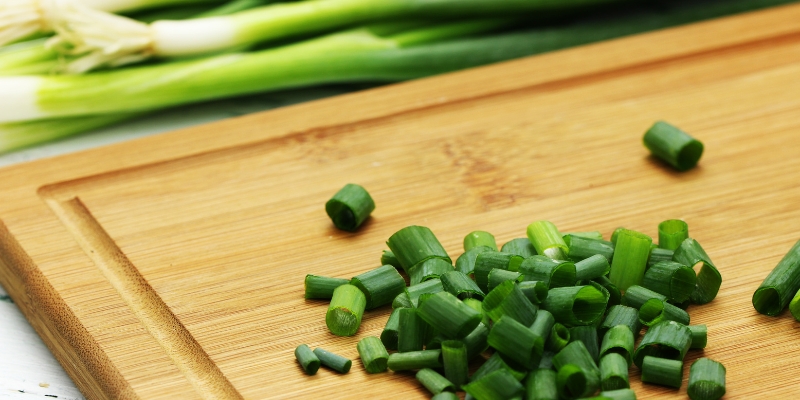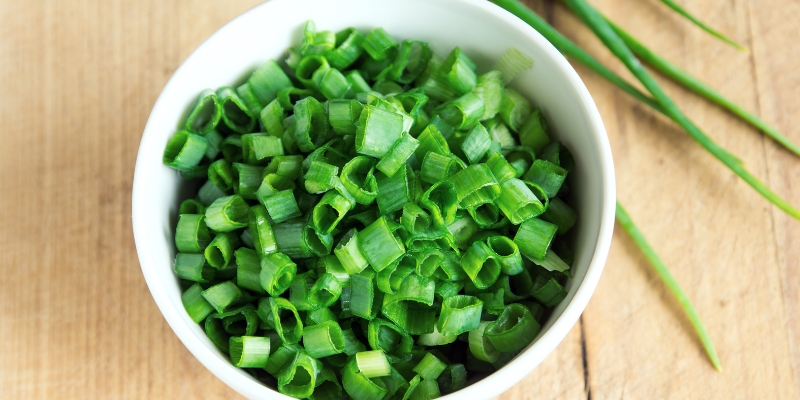Chive Mastery: Perfecting the Art of Back-Slicing for Culinary Delight
Sep 02, 2023 By Fabian Forte
Chives are a great choice to add an intense burst of taste and a sense of freshness to your food. These tasty green herbs are long and thin, and because they are so versatile, they can be used in many different ways. Back-slicing is a method that can be used to improve the look and taste of food.
Before they can be used to make back-sliced chives, newly picked chives must be gathered in big groups and washed well. The chives should then be put on a cutting board neat and orderly. Use a sharp knife and hold it at a 45-degree angle to cut the chives. Use a cutting action to cut the chives. Please start at the bottom and move away from the plant as you go up and away.

What Are Chives?
Chives, or allium schoenoprasum, are in the same family as onions. They look like grass and are also in this family. Garlic, onions, shallots, and leeks are all linked to chives. Because chives taste like onions, they have become one of the most popular ways to dress up food worldwide. You can find chives in the fresh produce area of the grocery store or at a farmer's market. Chives are trees that produce tasty purple flowers called "chive blossoms." Onions are another common name for onions. Before eating a chive plant, most people take off the flowers before picking it.
What Do Chives Taste Like?
Chives taste mild like onions and garlic, their relatives. Chives are garlic and onion relatives. At some point, onions, garlic, and chives came from the same plant. Chives taste strong of onion and have a hint of garlic in the background. On the other hand, chives are used more as a condiment than a central part of the meal because their flavor isn't as strong as that of either of these more prominent ingredients. Chives are more often used as a decoration than as a central part of a meal.
How to cut chives:
This method lets you cut thin slices every time, making the food you're making taste better and make it look more appetizing. When chives are cut on the diagonal, Add flavour and colour to any meal. This is true whether you put the finishing touches on a salad, a soup, or a primary food. Chives give whatever they are added to taste and color.
Back-Slicing Fundamentals, Step 1
Kitchen back-slicing requires precise knife angle and action. Using this method, elongated, beautiful chive pieces enhance your food’s look and taste.
Chive Preparation, Step 2
Perfectly prepared chives are crucial before back-slicing. Dust is removed with a thorough yet gentle cold water washing. Then, use a clean kitchen towel or absorbent paper to dry them for a clean canvas for your cooking.

Set Up the Cutting Board, Step 3
Your back-slicing starts with a strong cutting board. Use a stable surface to position the cutting board. Chive should be parallel to the board. Importantly, this alignment defines your slicing action and ensures consistent output.
Knife Selection, Step 4
A good knife is essential for back-slicing. Pick a sharp chef's or utility knife. Precision cuts and delicate chive pieces are made more accessible by the edge's keenness.
Back-Slice, Step 5
A determined knife angle is critical to back-slicing. Cut chive stems with the knife approximately parallel. Slicing begins at the chive bunch tip. The blade's modest rearward motion creates elongated slices. Elegantize your chive pieces using this approach.
Consistency, Step 6
Masterful back-slicing requires consistency. Hold the knife at the same angle and pressure as you cut the chives. This careful process gives each slice a polished look and length.
Leading the Bunch, Step 7
For accuracy, your non-dominant hand should secure the chive bunch on the cutting surface. Protect your fingers from nicks by curling them when cutting the chives.
Progress and Finish, Step 8
Work slowly back-slicing from the tip to the base of the chive bunch. With practice, you'll master the rhythm and slice chives perfectly.
Safety First, Step 9
It is essential to emphasize knife safety. Position your hands properly to keep your fingertips away from the blade. Sharp knives use less force and minimize accidents.
Back-sliced chive, step 10.
How well your back-slice offers up many culinary options. Chive pieces provide lovely garnishes for soups, salads, and omelets. Every pinch of back-sliced chives adds flavor and beauty to your meals.
Step 11: The Art of Knife Handling
Choose the Right Knife: Assessing chef's and utility knives for best back-slicing.
Step 13: Back-Sliced Chives Look Good
Elevating Presentation: How back-sliced chives bring elegance and color to foods. Back-sliced chives provide visual versatility to numerous culinary dishes.
Step14: Culinary Creativity with Back-Sliced Chives
Back-sliced chives may be utilized unexpectedly, from infused oils to compound butter. The mild onion taste of back-sliced chives and how it compliments diverse meals.
Step 15: Beginner Tips
Start small with a modest bunch of chives to gain back-slicing confidence. Patient and Progress: Knowing that practice and repetition are essential to achieving this talent.
Step 16: Modifications
Micro Slicing: Back-slicing tiny chive bits finer. Using back-sliced chive slices to create beautiful dish presentations.
Step 17: Freshness Preservation
Best techniques for keeping back-sliced chive slices to preserve taste and color. If chive slices lose their brightness before usage, revitalize them.
Step 18: Innovation and Experimentation
Blending Flavors: Mixing back-sliced chives with other herbs and substances to create new flavors. To create new culinary combinations, use back-sliced chives in fusion recipes.
Step 19: Inspiration and Chive Alternatives
Consider various herbs that can be back-sliced for different flavors. Professional chefs and culinary resources might inspire inventive ways to utilize back-sliced chives.
Step 20: Skill Sharing
Sharing the skill of back-slicing chives with friends, family, and budding cooks. Showcase your back-sliced chive-adorned meals on social media to inspire others.
These headers will assist you in explaining back-slicing chives and help readers master this culinary technique.
Conclusion:
To sum up, learning how to back-slice onions is a sure way to take your cooking skills to the next level and impress your guests with the food you make. Using the back-slicing method, you can make onions that are consistently thinly sliced and add flavor to a wide range of meals. If you follow the directions carefully, you'll soon be able to slice chives like a pro and impress your friends and family with the beautiful show you made.
You will need a steady hand and a sharp and smooth knife on the blade to do the job well. Adding back-sliced onions to the main dish's salad, soup, and decorations made them taste better. Grab a knife and some fresh onions, and get ready to take your cooking to the next level now that you know how to use this simple but effective method.








